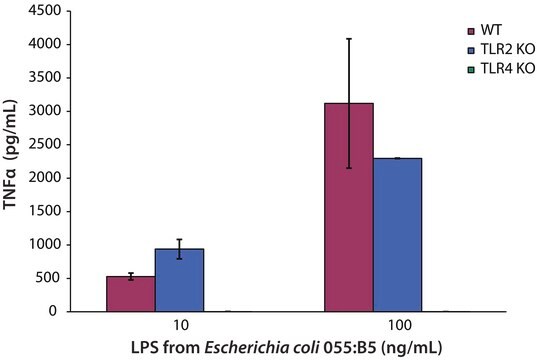L3023
Lipopolysaccharides from Escherichia coli O111:B4
Detoxified
Synonym(s):
LPS
Sign Into View Organizational & Contract Pricing
All Photos(1)
About This Item
Recommended Products
biological source
Escherichia coli (O111:B4)
Quality Level
form
lyophilized powder
color
white to beige
solubility
water: soluble
shipped in
ambient
storage temp.
2-8°C
Looking for similar products? Visit Product Comparison Guide
General description
This product is extracted from E. coli serotype O111:B4 and purified by chromatography. The source strain is from a private collection. The lipid A moiety has been partially delipidated by alkaline hydrolysis. Removal of the fatty acid portions of lipid A results in a detoxified LPS with an endotoxin level about 10,000 times lower than that of the parent LPS.
Application
Lipopolysaccharides (LPSs) are characteristic components of the cell wall of Gram-negative bacteria. LPS and its lipid A moiety stimulate cells of the innate immune system by the Toll-like receptor 4 (TLR4), a member of the Toll-like receptor protein family, which recognizes common pathogen-associated molecular-patterns (PAMPs).
Biochem/physiol Actions
Lipopolysaccharides (LPS) are localized in the outer layer of the membrane and are, in noncapsulated strains, exposed on the cell surface. They contribute to the integrity of the outer membrane, and protect the cell against the action of bile salts and lipophilic antibiotics.
Preparation Note
Chromatographically purified; delipidized by alkaline hydrolysis
The product is soluble in water (5 mg/ml) or cell culture medium (1 mg/ml) yielding a hazy, faint yellow solution. A more concentrated, though still hazy, solution (20 mg/ml) has been achieved in aqueous saline after vortexing and warming to 70-80 oC. Lipopolysaccharides are molecules that form micelles in every solvent. Hazy solutions are observed in water and phosphate buffered saline. Organic solvents do not give clearer solutions. Methanol yields a turbid suspension with floaters, while water yields a homogeneously hazy solution.
Other Notes
To gain a comprehensive understanding of our extensive range of Lipopolysaccharides for your research, we encourage you to visit our Carbohydrates Category page.
related product
Product No.
Description
Pricing
Signal Word
Danger
Hazard Statements
Precautionary Statements
Hazard Classifications
Acute Tox. 2 Oral
Storage Class Code
6.1A - Combustible acute toxic Cat. 1 and 2 / very toxic hazardous materials
WGK
WGK 3
Flash Point(F)
Not applicable
Flash Point(C)
Not applicable
Personal Protective Equipment
dust mask type N95 (US), Eyeshields, Gloves
Choose from one of the most recent versions:
Already Own This Product?
Find documentation for the products that you have recently purchased in the Document Library.
Customers Also Viewed
Hua Qiu et al.
Drug design, development and therapy, 13, 589-600 (2019-02-28)
Jie-Du-Hua-Yu (JDHY) granule is a combination of six traditional Chinese medicines with known therapeutic effect in treating acute liver failure (ALF). The aim of this study was to investigate the amelioration efficacy of JDHY in lipopolysaccharide/D-galactosamine (LPS/D-GalN)-induced ALF in rat
Carol L Ladner-Keay et al.
Prion, 10(6), 466-483 (2016-12-03)
Conversion of native cellular prion protein (PrPc) from an α-helical structure to a toxic and infectious β-sheet structure (PrPSc) is a critical step in the development of prion disease. There are some indications that the formation of PrPSc is preceded
Gabrielle R Andrade et al.
Human vaccines & immunotherapeutics, 10(10), 2864-2874 (2014-12-09)
E. coli O111 strains are responsible for outbreaks of blood diarrhea and hemolytic uremic syndrome throughout the world. Because of their phenotypic variability, the development of a vaccine against these strains which targets an antigen that is common to all
Rhonda H Wilson et al.
American journal of respiratory and critical care medicine, 180(8), 720-730 (2009-08-08)
In humans, immune responses to inhaled aeroallergens develop in the lung and draining lymph nodes. Many animal models of asthma bypass this route and instead use intraperitoneal injections of allergen using aluminum hydroxide as an adjuvant. We investigated whether allergic
Mohamed El Gazzar et al.
Molecular and cellular biology, 29(7), 1959-1971 (2009-01-23)
Epigenetic silencing of tumor necrosis factor alpha (TNF-alpha) and interleukin 1beta (IL-1beta) transcription occurs in blood leukocytes of animals and humans after the initiation of severe systemic inflammation (SSI). We previously reported that the epigenetic signature requires induction of NF-kappaB
Our team of scientists has experience in all areas of research including Life Science, Material Science, Chemical Synthesis, Chromatography, Analytical and many others.
Contact Technical Service



